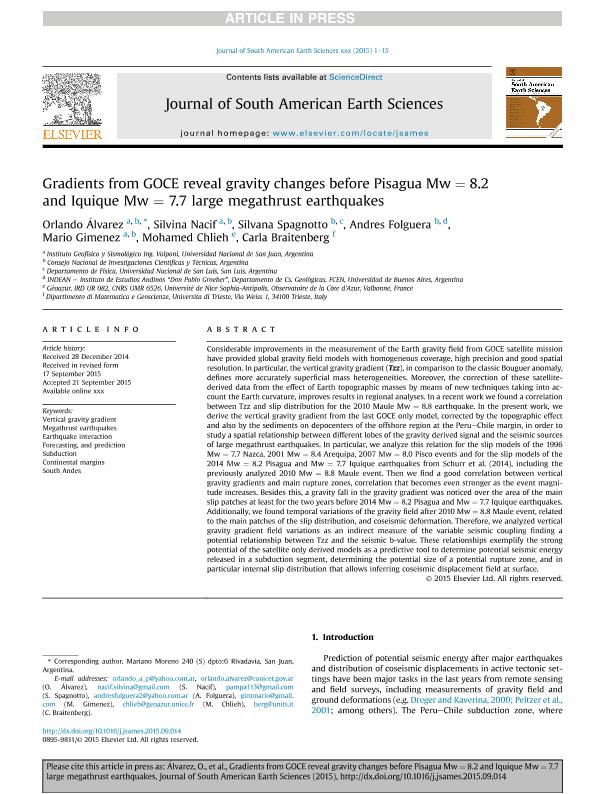Mostrar el registro sencillo del ítem
dc.contributor.author
Alvarez Pontoriero, Orlando

dc.contributor.author
Nacif Suvire, Silvina Valeria

dc.contributor.author
Spagnotto, Silvana Liz

dc.contributor.author
Folguera Telichevsky, Andres

dc.contributor.author
Gimenez, Mario Ernesto

dc.contributor.author
Chlieh, Mohamed
dc.contributor.author
Braitenberg, Carla
dc.date.available
2017-06-19T20:18:45Z
dc.date.issued
2015-12
dc.identifier.citation
Alvarez Pontoriero, Orlando; Nacif Suvire, Silvina Valeria; Spagnotto, Silvana Liz; Folguera Telichevsky, Andres; Gimenez, Mario Ernesto; et al.; Gradients from GOCE reveal gravity changes before Pisagua Mw = 8.2 and Iquique Mw = 7.7 large megathrust earthquakes; Elsevier; Journal Of South American Earth Sciences; 64; 2; 12-2015; 273-287
dc.identifier.issn
0895-9811
dc.identifier.uri
http://hdl.handle.net/11336/18477
dc.description.abstract
Considerable improvements in the measurement of the Earth gravity field from GOCE satellite mission have provided global gravity field models with homogeneous coverage, high precision and good spatial resolution. In particular, the vertical gravity gradient (Tzz), in comparison to the classic Bouguer anomaly, defines more accurately superficial mass heterogeneities. Moreover, the correction of these satellitederived data from the effect of Earth topographic masses by means of new techniques taking into account the Earth curvature, improves results in regional analyses. In a recent work we found a correlation between Tzz and slip distribution for the 2010 Maule Mw ¼ 8.8 earthquake. In the present work, we derive the vertical gravity gradient from the last GOCE only model, corrected by the topographic effect and also by the sediments on depocenters of the offshore region at the PerueChile margin, in order to study a spatial relationship between different lobes of the gravity derived signal and the seismic sources of large megathrust earthquakes. In particular, we analyze this relation for the slip models of the 1996 Mw ¼ 7.7 Nazca, 2001 Mw ¼ 8.4 Arequipa, 2007 Mw ¼ 8.0 Pisco events and for the slip models of the 2014 Mw ¼ 8.2 Pisagua and Mw ¼ 7.7 Iquique earthquakes from Schurr et al. (2014), including the previously analyzed 2010 Mw ¼ 8.8 Maule event. Then we find a good correlation between vertical gravity gradients and main rupture zones, correlation that becomes even stronger as the event magnitude increases. Besides this, a gravity fall in the gravity gradient was noticed over the area of the main slip patches at least for the two years before 2014 Mw ¼ 8.2 Pisagua and Mw ¼ 7.7 Iquique earthquakes. Additionally, we found temporal variations of the gravity field after 2010 Mw ¼ 8.8 Maule event, related to the main patches of the slip distribution, and coseismic deformation. Therefore, we analyzed vertical gravity gradient field variations as an indirect measure of the variable seismic coupling finding a potential relationship between Tzz and the seismic b-value. These relationships exemplify the strong potential of the satellite only derived models as a predictive tool to determine potential seismic energy released in a subduction segment, determining the potential size of a potential rupture zone, and in particular internal slip distribution that allows inferring coseismic displacement field at surface.
dc.format
application/pdf
dc.language.iso
eng
dc.publisher
Elsevier

dc.rights
info:eu-repo/semantics/openAccess
dc.rights.uri
https://creativecommons.org/licenses/by-nc-sa/2.5/ar/
dc.subject
Sismos
dc.subject
Gravedad
dc.subject
Trinchera
dc.subject.classification
Geología

dc.subject.classification
Ciencias de la Tierra y relacionadas con el Medio Ambiente

dc.subject.classification
CIENCIAS NATURALES Y EXACTAS

dc.title
Gradients from GOCE reveal gravity changes before Pisagua Mw = 8.2 and Iquique Mw = 7.7 large megathrust earthquakes
dc.type
info:eu-repo/semantics/article
dc.type
info:ar-repo/semantics/artículo
dc.type
info:eu-repo/semantics/publishedVersion
dc.date.updated
2017-06-19T17:27:36Z
dc.journal.volume
64
dc.journal.number
2
dc.journal.pagination
273-287
dc.journal.pais
Países Bajos

dc.journal.ciudad
Amsterdam
dc.description.fil
Fil: Alvarez Pontoriero, Orlando. Universidad Nacional de San Juan. Facultad de Ciencias Exactas, Fisicas y Naturales. Instituto Geofisico Sismologico Volponi; Argentina. Consejo Nacional de Investigaciones Científicas y Técnicas; Argentina
dc.description.fil
Fil: Nacif Suvire, Silvina Valeria. Universidad Nacional de San Juan. Facultad de Ciencias Exactas, Fisicas y Naturales. Instituto Geofisico Sismologico Volponi; Argentina. Consejo Nacional de Investigaciones Científicas y Técnicas; Argentina
dc.description.fil
Fil: Spagnotto, Silvana Liz. Universidad Nacional de San Luis. Facultad de Ciencias Físico Matemáticas y Naturales. Departamento de Física; Argentina. Consejo Nacional de Investigaciones Científicas y Técnicas; Argentina
dc.description.fil
Fil: Folguera Telichevsky, Andres. Consejo Nacional de Investigaciones Científicas y Técnicas. Oficina de Coordinación Administrativa Ciudad Universitaria. Instituto de Estudios Andinos "Don Pablo Groeber". Universidad de Buenos Aires. Facultad de Ciencias Exactas y Naturales. Instituto de Estudios Andinos ; Argentina
dc.description.fil
Fil: Gimenez, Mario Ernesto. Universidad Nacional de San Juan. Facultad de Ciencias Exactas, Fisicas y Naturales. Instituto Geofisico Sismologico Volponi; Argentina. Consejo Nacional de Investigaciones Científicas y Técnicas; Argentina
dc.description.fil
Fil: Chlieh, Mohamed. Observatoire de la Cote D'Azur; Francia
dc.description.fil
Fil: Braitenberg, Carla. Universita Degli Studi Di Trieste; Italia
dc.journal.title
Journal Of South American Earth Sciences

dc.relation.alternativeid
info:eu-repo/semantics/altIdentifier/doi/http://dx.doi.org/10.1016/j.jsames.2015.09.014
dc.relation.alternativeid
info:eu-repo/semantics/altIdentifier/url/http://www.sciencedirect.com/science/article/pii/S0895981115300651
Archivos asociados
